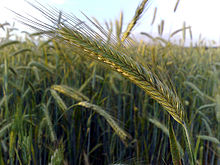Rye
| Rye | |
|---|---|
 |
|
| Scientific classification | |
| Kingdom: | Plantae |
| (unranked): | Angiosperms |
| (unranked): | Monocotyledons |
| (unranked): | Commelinids |
| Order: | Poales |
| Family: | Poaceae |
| Subfamily: | Pooideae |
| Tribe: | Triticeae |
| Genus: | Secale |
| Species: | S. cereale |
| Binomial name | |
|
Secale cereale L. |
|
| Synonyms | |
|
Secale fragile M.Bieb. |
|
Secale fragile M.Bieb.
Rye (Secale cereale) is a grass grown extensively as a grain, a cover crop and a forage crop. It is a member of the wheat tribe (Triticeae) and is closely related to barley (genus Hordeum) and wheat (Triticum). Rye grain is used for flour, rye bread, rye beer, crisp bread, some whiskeys, some vodkas, and animal fodder. It can also be eaten whole, either as boiled rye berries or by being rolled, similar to rolled oats.
Rye is a cereal grain and should not be confused with ryegrass, which is used for lawns, pasture, and hay for livestock.
Rye is one of a number of species that grow wild in central and eastern Turkey and in adjacent areas. Domesticated rye occurs in small quantities at a number of Neolithic sites in (Asia Minor) Turkey, such as the Pre-Pottery Neolithic B Can Hasan III near Çatalhöyük, but is otherwise absent from the archaeological record until the Bronze Age of central Europe, c. 1800–1500 BCE. It is possible that rye traveled west from (Asia Minor) Turkey as a minor admixture in wheat (possibly as a result of Vavilovian mimicry), and was only later cultivated in its own right. Although archeological evidence of this grain has been found in Roman contexts along the Rhine, Danube, and in Ireland and Britain,Pliny the Elder was dismissive of rye, writing that it "is a very poor food and only serves to avert starvation" and spelt is mixed into it "to mitigate its bitter taste, and even then is most unpleasant to the stomach".
...
Wikipedia
